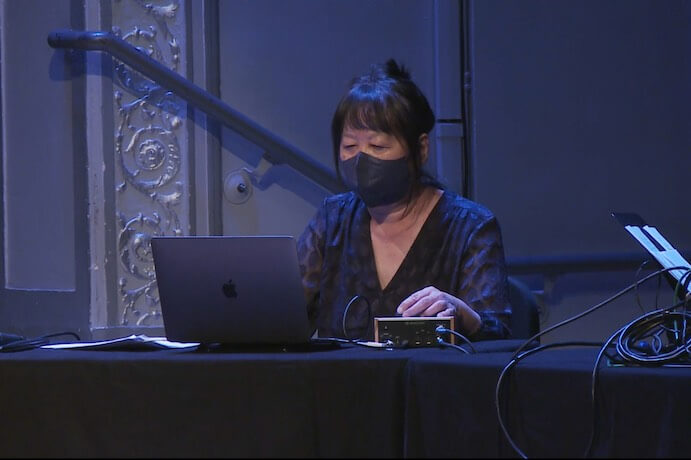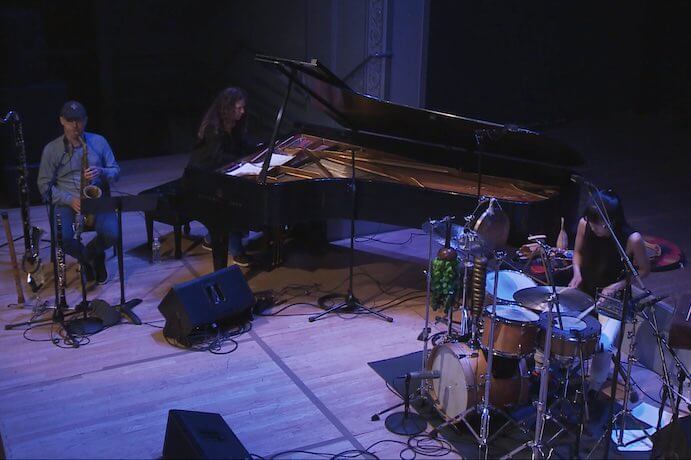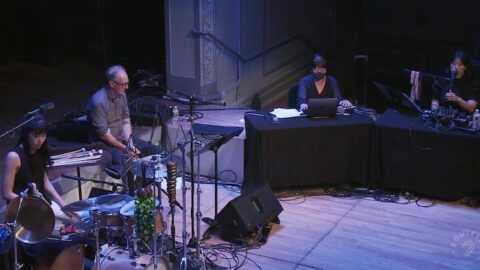A drum set, a few woodwind instruments, a piano, a couple of bagpipes, and electronics waited onstage at Roulette on the evening of May 24, 2022. Audience members filtered in and out of the ground floor and balcony, clustering in small groups of friends and fanning out across the hall. Friendly chatter and laughs rang out across the room long before and after any music did. Eventually, the lights dimmed and electronic musician Ikue Mori, woodwind player Ned Rothenberg, pianist Sylvie Courvoisier, bagpipe player David Watson, vocalist Charmaine Lee, and percussionist Sae Hashimoto took the stage, storming through boisterous solos and ominous quietude for about an hour.
They were playing Tracing the Magic, a new suite by Mori that will be released as an album in June on John Zorn’s Tzadik label. Throughout her storied career, Mori has worked across musical genres: In her early days, she was a founding member of no-wave band DNA, and since then, she’s experimented with drum machine improvisation and electronic composition. As a composer, she’s often worked with labyrinthine textures, and Tracing the Magic continues along this path, taking inspiration from women artists like painter Agnes Martin and ink painting and print artist Toko Shinoda to create entwined musical lines. At the live performance, bold solos and ever-evolving textures grew into waves of lush sound, creating a maze of entangled melodies.

At the concert’s understated beginning, static emanated from Mori’s laptop and each instrument flitted in and out: A vocal murmur fluttered here, a piano tapped there, creating a stretch of sporadic thrums. The ensemble’s melodies gradually swelled into longer phrases that overlapped and merged, forming a web of different textures. Rothenberg’s tenuous clarinet paired with Courvoisier’s reverberant piano and Hasimoto’s crisp triangle to created a winding, haunted counterpoint that became increasingly frenzied and then fizzled away.
Most of the pieces followed this general pattern: Electronics entered with hushed sizzles as other instruments appeared. It took some time to warm up to this structure, though. At first, the music felt scattered, collecting up energy but never quite reaching a tipping point. Each instrument seemed as if it existed in its own world. The second movement, for example, felt disconnected: Prickly electronics attempted to mesh with a plodding piano and shakuhachi melody. Every layer felt mesmerizing on its own, but together, they didn’t cohere. Each line moved in parallel and never intersected.

But after those first couple of movements, the concert quickly became captivating. At its pinnacle, a full-bodied drone created by a squealing bagpipe and exuberant bass clarinet filled the room with transfixing sound. Then, a pulsing melody played by piano and drums slashed the drone off to form a chugging beat. As the charismatic groove blossomed, the sound that had been building up for so long finally exploded, and despite contrasting textures, each instrument felt interconnected. Courvoisier’s piano rumbled in one corner, venturing between traditionally played notes and extended techniques, such as string plucking, while Lee’s crisp, electronically distorted vocals cut through the fold in and Watson’s piercing bagpipe blared above them all. The audience couldn’t help but burst into applause once the movement ended, and a few cheers flickered throughout the room, too. The music engrossed us until the very end; its wild ups and downs sucking us in.
Mori’s vision was its most invigorating in those moments of deep connection. They drove the piece to its spellbinding, soft end, which was a drastic change from the thunderous climax, made of swishing percussion and distant, roiling piano that eerily faded away. But the moment was just as alive — every musician was in-sync as they gradually decrescendoed. These drastic moments showcased Mori’s penchant for exploring shapeshifting sound, with particular respect to her interest in how texture can drive musical changes. In fact, Tracing the Magic thrived in moments of organized chaos that spotlighted the ways each instrument could mesh or contrast with the others. And as sound fractured and splintered into a hundred different directions, bouncing against every corner of the room with fervor, it returned a little more united than before.
I CARE IF YOU LISTEN is an editorially-independent program of the American Composers Forum, funded with generous donor and institutional support. Opinions expressed are solely those of the author and may not represent the views of ICIYL or ACF.
A gift to ACF helps support the work of ICIYL. For more on ACF, visit the “At ACF” section or composersforum.org.
























